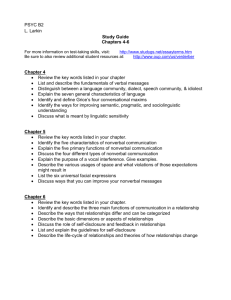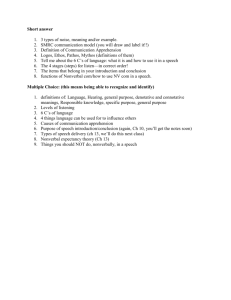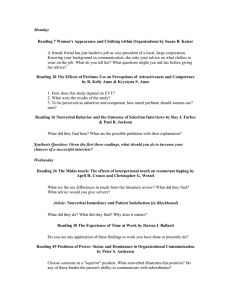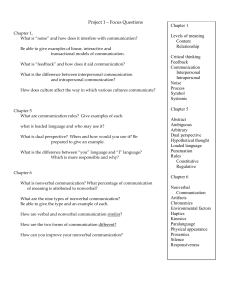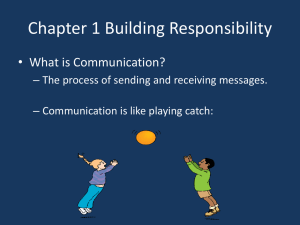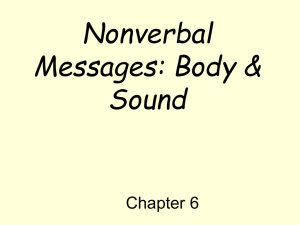PUBLIC SPEAKING PART I Nonverbal Communication
advertisement
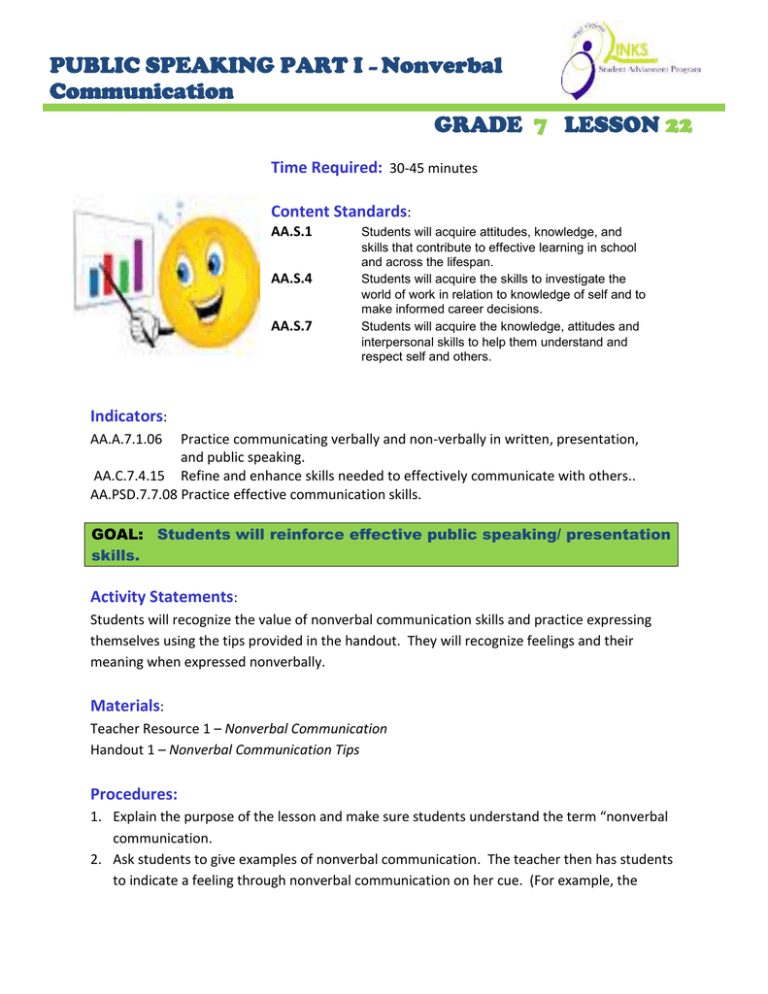
PUBLIC SPEAKING PART I – Nonverbal Communication GRADE 7 LESSON 22 Time Required: 30-45 minutes Content Standards: AA.S.1 AA.S.4 AA.S.7 Students will acquire attitudes, knowledge, and skills that contribute to effective learning in school and across the lifespan. Students will acquire the skills to investigate the world of work in relation to knowledge of self and to make informed career decisions. Students will acquire the knowledge, attitudes and interpersonal skills to help them understand and respect self and others. Indicators: AA.A.7.1.06 Practice communicating verbally and non-verbally in written, presentation, and public speaking. AA.C.7.4.15 Refine and enhance skills needed to effectively communicate with others.. AA.PSD.7.7.08 Practice effective communication skills. GOAL: Students will reinforce effective public speaking/ presentation skills. Activity Statements: Students will recognize the value of nonverbal communication skills and practice expressing themselves using the tips provided in the handout. They will recognize feelings and their meaning when expressed nonverbally. Materials: Teacher Resource 1 – Nonverbal Communication Handout 1 – Nonverbal Communication Tips Procedures: 1. Explain the purpose of the lesson and make sure students understand the term “nonverbal communication. 2. Ask students to give examples of nonverbal communication. The teacher then has students to indicate a feeling through nonverbal communication on her cue. (For example, the PUBLIC SPEAKING PART I GRADE 7 LESSON 22 3. 4. 5. 6. 7. 8. 9. teacher may say “stressed out” and students nonverbally express “stressed out”. The teacher looks around the room quickly to confirm that students are indeed expressing some form of “stressed out” nonverbally.) The teacher continues with two or three other feelings such as angry, surprised, etc. Discuss how nonverbal cues may have different meanings depending on the person and the situation. The teacher explains that the next activity will involve role plays using nonverbal communication. Use Teacher Resource 1 – Nonverbal Communication as a teacher resource for role plays using nonverbal communication. After each role play, ask students to practice reading nonverbal communication by describing feelings and mood of participants based on their nonverbal communication. Explain that students will investigate tips for effective nonverbal communication. Assign teams of two or three students for a “Pair and Share” activity. Review the procedure for a “Pair and Share”. (Students will divide reading of the Handout so that all members of the group have a similar amount to read. After 3 to 5 minutes of reading their individual sections, they will take turns explaining to their group. In this manner, they will learn about the entire article.) Distribute copies of Handout 1 – Nonverbal Communication Tips. Announce that students are “on the clock” and have four minutes to divide and read their portion of the article. After four minutes, announce that students have 3 minutes to share their section within their group. Students take turns explaining their own section of Handout 1 – Nonverbal Communication Tips within their groups. Finally, ask students for a quick report out from each group on key points they learned from the article. Discussion: Why are nonverbal communication skills important? Describe nonverbal and verbal skills used in today’s lesson. What might happen if we aren’t paying attention to our nonverbal communication? Are nonverbal skills important to both the speaker and the listener? Explain. Which are more important – nonverbal or verbal skills? Why? How is communication part of the 21st Century Skills students must have? Does 21st Century communication include nonverbal communication? Give examples of nonverbal communication strategies that might be helpful. Can we improve our communication skills? How? PUBLIC SPEAKING PART I GRADE 7 LESSON 22 Additional Resources: Improve Speaking Skills - http://newteachersupport.suite101.com/article.cfm/improve_speaking_skills Body Language - http://www.moneyinstructor.com/lesson/bodylanguage.asp Rubrics for Effective Communication - http://www.doe.state.la.us/lde/lcet/intech/introduction/georgia/examplerubrics.htm Nonverbal Communication - http://www.blatner.com/adam/level2/nverb1.htm Positive Indicators - http://www.education.com/reference/article/positive-indicators-nonverbal-communication/ Positive Nonverbal Communication - http://www.plsweb.com/resources/newsletters/enews_archives/25/2002/10/02/ Extension Activities: Students may investigate the importance of nonverbal communication in the workplace, during job interviews, or other career related settings. They may prepare skits utilizing what they have learned about communication to present to the class. Students may practice using nonverbal communication throughout subsequent lessons as they continue to learn about and practice communication skills. Other activities as assigned by advisor. Developed by: Dr. Penny Fisher, Director, Putnam County Schools (2009)

